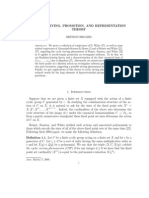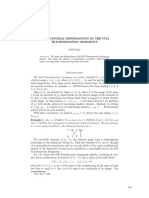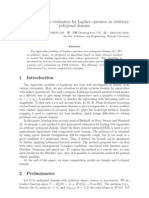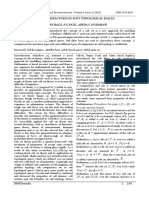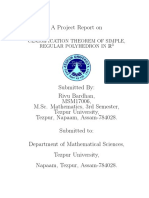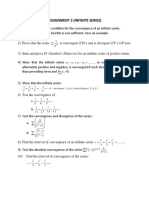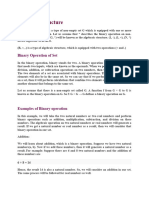Computation of Cohomology
Computation of Cohomology
Uploaded by
Jhon Alexander Vasquez NaranjoCopyright:
Available Formats
Computation of Cohomology
Computation of Cohomology
Uploaded by
Jhon Alexander Vasquez NaranjoOriginal Description:
Copyright
Available Formats
Share this document
Did you find this document useful?
Is this content inappropriate?
Copyright:
Available Formats
Computation of Cohomology
Computation of Cohomology
Uploaded by
Jhon Alexander Vasquez NaranjoCopyright:
Available Formats
Computation of Cohomology Operations on Finite Simplicial Complexes
R. GonzlezD P. Real a az,
Dept. of Applied Math., University of Seville, Spain {rogodi, real}@us.es
Abstract. We propose a method for calculating cohomology operations for nite simplicial complexes. Of course, there exist wellknown methods for computing (co)homology groups, for example, the reduction algorithm consisting in reducing the matrices corresponding to the dierential in each dimension to the Smith normal form, from which one can read o (co)homology groups of the complex [Mun84], or the incremental algorithm for computing Betti numbers [DE93]. However, there is a gap in the literature concerning general methods for computing cohomology operations. For a given nite simplicial complex K, we sketch a procedure including the computation of some primary and secondary cohomology operations and the A algebra structure on the cohomology of K. This method is based on the transcription of the reduction algorithm mentioned above, in terms of a special type of algebraic homotopy equivalences, called a contraction, of the (co)chain complex of K to a minimal (co)chain complex M (K). For instance, whenever the ground ring is a eld or the (co)homology of K is free, then M (K) is isomorphic to the (co)homology of K. Combining this contraction with the combinatorial formulae for Steenrod reduced pth powers at cochain level developed in [GR99] and [Gon00], these operations at cohomology level can be computed. Finally, a method for calculating Adem secondary cohomology operations q : Ker(Sq 2 H q (K)) H q+3 (K)/Sq 2 H q (K) is showed.
Authors are partially supported by the PAICYT research project FQM-296 from Junta de Andalucia and the DGESSEUID research project PB981621C0202 from Education and Science Ministry (Spain).
Introduction
Particular important topological invariants are the (co)homology groups. In a certain way, these groups measure the degree of connectedness of the space. Although there are plenty of programs for calculating (co)homology groups of nite simplicial complexes, we have not found any general software for computing cohomology operations. Our main motivation is the design of a program for computing all sort of cohomology invariants on nite simplicial complexes: (co)homology groups, cup product, Bockstein cohomology operation, cohomology operations determined by homomorphisms of coecient groups, Steenrod squares and reduced pth powers, Pontrjagin squares and pth powers, the A algebra structure of cohomology, higher cohomology operations, etc. In this paper, we give a solution to the problem of computing Steenrod squares and reduced pth powers [Ste47,ES62] and Adem secondary cohomology operations [Ade52,Ade58]. Our approach is based on the translation of the wellknown reduction algorithm for computing (co)homology groups [Mun84] in terms of homotopy equivalences. In that way, we have a description of the generators of the (co)homology groups in terms of cochains. In fact, this is sucient to enable us to determine the eect of the induced maps between cohomology groups corresponding to cochain maps. Using the same approach we think that the rest of primary cohomology operations could be attacked.
Background
We give a brief summary of concepts and notation used in the following sections. Our terminology follows Munkres [Mun84]. For 0 q n, a qsimplex in Rn is the convex hull of a set T of q + 1 anely independent points (v0 , ..., vq ). The dimension of is || = q. For every nonempty U T , the simplex dened by U is a face of . A simplicial complex K is a collection of simplices satisfying the following properties: If is a face of and K then K. If , K then is either empty or a face of both. The set of all the qsimplices of K is denoted by K (q) . The largest dimension of any simplex in K is the dimension of K. A simplex in K is maximal if it is not face of any simplex in K. Therefore, K can be given by the set of its maximal simplices. A subset L K is a subcomplex of K if it is a simplicial complex itself. All simplices in this paper have nite dimension and all simplicial complexes are nite collections. From now on, K denotes a nite simplicial complex.
The oriented qsimplex = [v0 , ..., vq ] is the equivalence class of the particular ordering (v0 , ..., vq ). Two orderings are equivalent if they dier from one another by an even permutation. Let denote an abelian group. A formal sum, 1 1 + + n n , where i and i are oriented qsimplices, is called a qchain. The chain complex canonically associated to K, denoted by C (K), is the family of groups such that in each dimension q, Cq (K) is the group of qchains in K. The boundary of a qsimplex = [v0 , v1 , ..., vq ] is the (q 1)chain
q
q =
i=0
(1)i [v0 , v1 , . . . , vi , . . . , vq ] ,
where the hat means that vi is omitted. By linearity, the boundary operator q can be extended to qchains, where it is a homomorphism. It is clear that for each qsimplex j there exist unique integers ij such that q (j ) =
i K (q1)
ij i .
The matrix Aq = (ij ) is the matrix of q relative to the bases K (q) and K (q1) . The group of qcycles, Zq (K), is the kernel of q , and dene Z0 (K) = C0 (K). The group of qboundaries, Bq (K), is the image of q+1 , that is, the subgroup of qchains b Cq (K) for which there exists a (q + 1)chain a with b = q+1 a. It can be shown that q q+1 is null so Bq (K) is a subgroup of Zq (K). Then, the qth homology group Hq (K) = Zq (K)/Bq (K) can be dened for each integer q. Let K and L be two simplicial complex. A chain map f : C (K) C (L) is a family of homomorphisms {fq : Cq (K) Cq (L)}q0 such that q fq = fq1 q , for all q. Dual concepts to the previous ones can be dened. The cochain complex canonically associated to K, C (K), is the family C (K) = {C q (K), q }q0 , where C q (K) = Hom(Cq (K); ) = {c : Cq (K) ,
c is a homomorphism}
and q : C q (K) C q+1 (K) called the coboundary operator is given by q (c)(a) = c(q+1 a) ,
where c C q (K) and a Cq+1 (K). Observe that a qcochain can be dened only on K (q) and extended to Cq (K) by linearity. Moreover, if is a ring, then a basis of C q (K) is the set of homomorphisms : Cq (K) , such that if K (q) , then ( ) = 1 if = , and ( ) = 0 otherwise. Z q (K) and B q (K) are the kernel of q and the image of q1 , respectively. The elements in Z q (K) are called qcocycles and those in B q (K) are called qcoboundaries. It is also satised that q q1 = 0 so the qth cohomology group H q (K) = Z q (K)/B q (K) can also be dened for each integer q. If is a ring, the cohomology of K is also a ring with the cup product : H p (K) H q (K) H p+q (K) dened at cocycle level by c c (v0 , v1 , . . . , vp+q ) = (c(v0 , . . . , vp ) c (vp , . . . , vp+q )) ,
where v0 < v1 < < vp+q , c is an pcocycle, c is a qcocycle and is the product on . We use in this paper a special type of homotopy equivalences. A contraction r of a chain complex N to another chain complex M is a set of three homomorphisms (f, g, ) where f : Nn Mn (projection) and g : Mn Nn (inclusion) are chain maps and satisfy that f g = 1M , and : Nn Nn+1 (homotopy operator) satises that 1N gf = N + N . Moreover, g = 0 , f = 0 , = 0 . A contraction up to dimension n of N to M consists in a set of three homomorphisms (f, g, ) such that fk : Nk Mk , g k : Mk N k and k1 : Nk1 Nk
are dened for all k n, n = 0, and the conditions of being a contraction are satised up to dimension n. Starting from a contraction r = (f, g, ) of N to M , it is possible to give another contraction r = (f , g , ) of Hom(N ; ) to Hom(M ; ) as follows: f : Hom(Nn ; ) Hom(Mn ; ) , g : Hom(Mn ; ) Hom(Nn ; ) ,
: Hom(Nn ; ) Hom(Nn1 ; ) , are such that
f (c) = cg ,
g (c ) = cf
and
(c) = c ,
where c Hom(Nn ; ) and c Hom(Mn ; ).
Minimal Chain Complexes
It is possible to translate the results of the reduction algorithm, discussed at length in [Mun84], in terms of homotopy equivalences. Combining this translation with modern homological perturbation techniques, algorithms for computing algebraic invariants, such as the A algebra structure on the cohomology of K and primary and secondary cohomology operations can be designed in an easy way. First of all, it is necessary to recall the reduction algorithm for computing homology groups of a nite simplicial complex K. This method consists in reducing the matrix A of the boundary operator in each dimension q, relative to given bases of Cq (K) and Cq1 (K), to its Smith normal form A (a matrix of integers satisfying that all its elements are zero except for 11 1 and 11 /22 / / for some integer ). This reduction is done in each dimension q modifying the given base of Cq1 (K), using the following elementary row operations on the matrix A: (1) Exchange row i by row k. (2) Multiply row i by 1. (3) Replace row i by row i + n(row k), where n is an integer and k = i. Of course, there are similar column operations on A corresponding to changes of basis of Cq (K). With this operations, the Smith normal form A of A can be obtained, relative to some bases {a1 , . . . ar } of Cq (K) and {e1 , . . . , es } of Cq1 (K). Then, (1) {a +1 , . . . , ar } is a basis of Zq (K), (2) {11 e1 , . . . , e } is a basis of Bq1 (K). Obviously, a dual treatment for C (K) and, consequently, for the cohomology H (K), can be done. A chain complex M (K) is called minimal if in each dimension q, Mq (K) is a nitely generated free abelian group and the Smith normal form A of the dierential of Mq (K) has the rst element 11 dierent from 1. An algebraic minimal model of K is a minimal chain complex M (K) together with a contraction of C (K) to M (K). Indeed, there is an algebraic minimal model for any nite simplicial complex K and any two algebraic minimal models of K are isomorphic.
Now, let us construct inductively an algebraic minimal model of a given nite simplicial complex K. Suppose that an algebraic minimal model up to dimension q 1 is already constructed. That is, we have a minimal chain complex M (K) such that Mi (K) = 0, i q, and a contraction up to dimension q 1, (f , g , ), of C (K) to M (K). Reduce the matrix of q : Cq (K) Cq1 (K) to its Smith normal form A . If the elements 11 = = tt = 1, for t (that is, (ai ) = ei for 1 i t), then dene M (K) as follows: Mi (K) = Mi (K), for i = q 1, q
Mq1 (K) = Mq1 (K) [e1 , . . . , et ] Mq (K) = Cq (K) [a1 , . . . , at ] where [a1 , . . . , at ] and [e1 , . . . , et ] are the free abelian groups generated by {a1 , . . . , at } and {e1 , . . . , et }, respectively. The formulae for the component morphisms of the contraction up to dimension q, (f, g, ), of C (K) to M (K) are: f (x) f (x) = 0 x g(y) = g (y) y if x [et+1 , . . . , es ] or x Ci (K), i < q, if x [e1 , . . . , et ] or x [a1 , . . . , at ], if x [at+1 , . . . , ar ], if y Mi (K), i < q, if y Mn (K),
(x) = (x) if x Ci (K), i < q 1, (ei ) = ai if 1 i t, (ei ) = 0 if t + 1 i s. In this way, we can determine an algebraic minimal model for a nite simplicial complex K. Observe that whenever is a eld or the homology of K is free, then M (K) is isomorphic to H (K) and, therefore, we can obtain a contraction of C (K) to its homology. Passing to cohomology does not represent a problem and a dual process can be done without eort. The fact of dealing with contractions is highly important in obtaining topology invariants such as the A algebra structure of the cohomology of K [GS86]. In particular, if = Q, then from the previous contraction connecting C (K) with H (K), it is possible to design an algorithm computing the commutative A algebra structure of H (K) reecting the complete rational homotopy type of K [Kad98]. We will see in the next section that the homotopy equivalence data structure is also essential in computing cohomology operations.
Steenrod Cohomology Operations
Let us suppose = Zp (p being a prime), then it is possible to construct an algebraic minimal model for any nite simplicial complex K, in which the associated contraction (f , g , ) connects C (K) with its cohomology. From this data and the combinatorial formulae for Steenrod squares and reduced pth powers [Ste47,ES62] at cochain level in terms of face operators established in [GR99,Gon00], Steenrod cohomology operations can eectively be computed. For instance, the formula for the Steenrod reduced power P1 : H (X) H p1 (X) at cochain level [Gon00] is:
p1 (j+1)q1
P1 (c)() =
j=1 i=jq
(1)(i+1)(q+1)+1 (c(v0 , . . . , vq ) (vq , . . . , v2q ) . . . c(v(j2)q , . . . , v(j1)q ) c(v(j1)q , . . . , viq , vi , . . . , v(j+1)q1 ) c(v(j+1)q1 , . . . , v(j+2)q1 ) . . . c(v(p2)q1 , . . . , v(p1)q1 ) c(v(p1)q1 , . . . , vpq1 ) c(viq , . . . , vi ) )
where c is a qcocycle, = (v0 , v1 , . . . , vpq1 ) is a (pq 1)simplex such that v0 < v1 < < vpq1 and is the product on Zp . Therefore, for calculating the cohomology class P1 () with H q (K), we only have to compute f P1 g (). In the particular case of Steenrod squares, Sq i : H (K; Z) H +i (K; Z2 ) , we can express them in a matrix form due to the fact that these cohomology operations are homomorphisms. Moreover, the process of diagonalization of such matrices can give us detailed information about the kernel and image of these cohomology operations.
Adem Secondary Cohomology Operations
For attacking the computation of secondary cohomology operations, we will see in this section that the homotopy operator of the contraction associated to an algebraic minimal model of a simplicial complex K is essential. First of all, we shall indicate how Adem secondary cohomology operations q : N q (K) H q+3 (K; Z2 )/Sq 2 H q+1 (K; Z) can be constructed (see [Ade52]). N q (K) denotes the kernel of Sq 2 : H q (K; Z) H q+2 (K; Z2 ) These operations appear using the known relation: Sq 2 Sq 2 + Sq 3 Sq 1 = 0 for any H (K; Z). For this particular relation there exist cochain mappings Ej : C (K K K K) C j (K) such that mod 2 c) = E3q3 (c4 ) ,
(c
q2
c)
(c
q2
c) + (c
q1
c)
(c
q1
where k is the cupk product [Ste47] and c is a qcochain. Recall that, at cochain level, Sq i (c) = c ji c mod 2, where c is a jcocycle. Then q is dened at cochain level by
q (c) = b
i+1
b+b
i+2
b + E3i+3 (c) + (c)
i1
(c) + (c)
(c) ,
where c is a qcocycle representative of a cohomology class of N q (K), b is a 1 (q + 1)cochain such that c q2 c = b and (c) = 2 (c q c + c). If Z2 is the ground ring, formulae for computing cupi products are well known [Ste47]. A method for obtaining economical formulae for E3i+3 in terms of face operations is given in [Gon00]. For example, E3 (c4 )() = (c(v0 , v2 , v3 ) c(v0 , v1 , v2 ) c(v3 , v4 , v5 ) c(v2 , v3 , v5 ) +c(v0 , v4 , v5 ) c(v3 , v4 , v5 ) c(v0 , v1 , v2 ) c(v0 , v1 , v2 ) +c(v0 , v1 , v5 ) c(v3 , v4 , v5 ) c(v1 , v2 , v3 ) c(v1 , v2 , v3 ) +c(v0 , v1 , v2 ) c(v2 , v4 , v5 ) c(v2 , v3 , v4 ) c(v2 , v3 , v4 ) +c(v0 , v1 , v2 ) c(v2 , v3 , v5 ) c(v3 , v4 , v5 ) c(v3 , v4 , v5 )) , where c is a 2cochain, = (v0 , v1 , ..., v5 ) is a 5simplex such that v0 < v1 < < v5 and is the product on Z2 . Therefore, the steps for computing q are the following:
1. Take N q (K) making use of the diagonalization of the matrix of Sq 2 in dimension q. 2. Compute b = Sq 2 g (). 3. Compute f g (). Note that it is very easy to prove that g ()
q+2
g () = Sq 2 g () ,
using the relation 1 g f = + .
Some Comments
All these results can be given in a more general framework working with not necessarily nite simplicial complexes. Nevertheless, a contraction of the chain complex associated to the simplicial complex to its (co)homology must exist in order to develop the method. Concerning the complexity, obtaining a contraction of a nite simplicial complex K to its (co)homology can be done using DelnadoEdelsbrunner incremental algorithm [ELZ00] which runs in time as most cubic in the number of simplices of the complex if the group of coecients is a eld. On the other hand, another datum to take into account is the number of summands of the formulae for computing cohomology operations at cocycle level. For example the number of summands of P1 over a qcocycle c and a (pq 1)-simplex is (p 1)q. Finally, in order to obtain the image of any cohomology operations at cochain level over a representative cocycle using our formulae, we have to compute them over a basis of C (K) in the desired dimension. A way of decreasing the complexity of this is to do a topological thinning of the simplicial complex K in order to obtain a thinned simplicial subcomplex Mtop (K) of K, such that there exists a contraction of C (K) to C (Mtop (K)) For example, one way to construct it is using simplicial collapses [For99]. Then we can apply our machinery to compute cohomology operations in the thinned simplicial complex Mtop (K) and the results can be easily interpreted in the big simplicial complex K.
10
References
[Ade52] J. Adem. The iteration of the Steenrod Squares in Algebraic Topology. Proc. Nat. Acad. Sci. USA, vol. 38 (1952) 720724. [Ade58] J. Adem. Operaciones Cohomolgicas de Segundo Orden Asociadas a Cuao drados de Steenrod. Symposium Internacional de Topolog Algebraica, Univ. a of Mexico, Mexico D.F. (1958) 186221. [DE93] C.J.A. Delnado, H. Edelsbrunner. An Incremental Algorithm for Betti Numbers of Simplicial Complexes. Proc. 9th Ann. Symp. Comput. Geom. (1993) 232239. [ELZ00] H. Edelsbrunner, D. Letscher, A. Zomorodian. Topological persistence and simplication. Proc. 41st Ann. IEEE Sympos. Found. Comput. Sci (2000), 454463. [ES62] N.E. Steenrod, D.B.A. Epstein. Cohomology Operations. Ann. of Math. Studies, vol. 50, Princeton University Press, 1962. [For99] R. Forman. Combinatorial Dierential Topology and Geometry. New Perspective in Geometric Combinatorics. MSRI Publications, vol. 8 (1999) 177206. [Gon00] R. GonzlezD a az. Cohomology Operations: A Combinatorial Approach. Ph. D. Thesis, Seville University, May 2000. [GR99] R. GonzlezD P. Real. A Combinatorial Method for Computing Steenrod a az, Squares. Journal of Pure and Applied Algebra, vol. 139 (1999) 89108. [GS86] V.K.A.M. Gugenheim, J. Stashe. On Perturbations and A Structures. Bull. Soc. Math. Belg., vol. 38 (1986), 237-246. [Kad98] T. Kadeishvili. A Algebra Structure in Cohomology and the Rational Homotopy Type. Forschungsschwerpunkt Geometrie, Universitt Heidelberg, Mata hematisches Institut, Heft Nr., vol. 37, 1998. [McL75] S. MacLane. Homology. Classics in Mathematics, SpringerVerlag, Berlin, 1995. Reprint of the 1975 edition. [Mun84] J.R. Munkres. Elements of Algebraic Topology. Addison-Wesley Publishing Company, 1984. [Rea96] P. Real. Homological Perturbation Theory and Associativity. Homology, Homotopy and its Applications, vol. 2, num. 5 (2000) 5188. [Ste47] N.E. Steenrod. Products of cocycles and extensions of mappings. Ann. of Math., vol. 48 (1947), 290320.
You might also like
- NLA10Document66 pagesNLA10luisNo ratings yet
- Possible Questions Exam Non-Equilibrium Statistical MechanicsDocument4 pagesPossible Questions Exam Non-Equilibrium Statistical MechanicsEgop3105No ratings yet
- Operator Algebras. Theory of C-Algebras and Von Neumann AlgebrasDocument529 pagesOperator Algebras. Theory of C-Algebras and Von Neumann AlgebrasDietethiqueNo ratings yet
- Klaus2016 Article OnCombinatorialGauss-BonnetTheDocument18 pagesKlaus2016 Article OnCombinatorialGauss-BonnetThe123chessNo ratings yet
- JDT CSPDocument55 pagesJDT CSPAnonymous UrVkcdNo ratings yet
- Asymptotic Behaviour at Infinity of Solutions of Second Kind Integral Equations On Unbounded Regions of RDocument22 pagesAsymptotic Behaviour at Infinity of Solutions of Second Kind Integral Equations On Unbounded Regions of RatpeplowNo ratings yet
- Codes and Projective SystemsDocument14 pagesCodes and Projective SystemsDaniele BalloNo ratings yet
- AbstractDocument19 pagesAbstractlancejoe2020No ratings yet
- A Generalized Composition Algorithm For Weighted Finite-State TransducersDocument4 pagesA Generalized Composition Algorithm For Weighted Finite-State TransducersJoaquínNo ratings yet
- Mass, Stiffness, and Damping Matrices From Measured Modal ParametersDocument5 pagesMass, Stiffness, and Damping Matrices From Measured Modal Parametersho-faNo ratings yet
- Geometry of Multiple Zeta ValuesDocument9 pagesGeometry of Multiple Zeta ValuesqwertyNo ratings yet
- Lec3 PDFDocument9 pagesLec3 PDFyacp16761No ratings yet
- K K K K 1 K 1 K K 0 K 00Document11 pagesK K K K 1 K 1 K K 0 K 00SHARAVATHI wardensharavNo ratings yet
- Solving The Quintic by Iteration - Doyle, PeterDocument30 pagesSolving The Quintic by Iteration - Doyle, PeterLucas KevinNo ratings yet
- Circulant MatricesDocument20 pagesCirculant MatricesAbeer ZahidNo ratings yet
- Split-Quaternion - Wikipedia: Q W + Xi + Yj + ZK, Has A Conjugate QDocument7 pagesSplit-Quaternion - Wikipedia: Q W + Xi + Yj + ZK, Has A Conjugate QLarios WilsonNo ratings yet
- The Quaternions With Applications To Rigid Body DyDocument17 pagesThe Quaternions With Applications To Rigid Body Dymirek.wijaszkaNo ratings yet
- Krylov Subspace MethodsDocument8 pagesKrylov Subspace MethodsHabita KadourNo ratings yet
- Nearly-Free Electrons Model: Jacob Shapiro December 18, 2012Document7 pagesNearly-Free Electrons Model: Jacob Shapiro December 18, 2012nouserhere123No ratings yet
- Amsj 2023 N01 05Document17 pagesAmsj 2023 N01 05ntuneskiNo ratings yet
- Numerical Analysis Lecture Notes: 7. Iterative Methods For Linear SystemsDocument28 pagesNumerical Analysis Lecture Notes: 7. Iterative Methods For Linear Systemsvivek patel100% (1)
- Mathematical Physics: L. A. Takhtajan and P. G. ZografDocument28 pagesMathematical Physics: L. A. Takhtajan and P. G. Zograf123chessNo ratings yet
- Additivity and Multiplicativity Properties of Some Gaussian Channels For Gaussian InputsDocument9 pagesAdditivity and Multiplicativity Properties of Some Gaussian Channels For Gaussian InputsgejikeijiNo ratings yet
- Quantum Field Theory Notes by JaffeDocument17 pagesQuantum Field Theory Notes by JaffedbranetensionNo ratings yet
- Formal Non-Commutative Symplectic GeometryDocument18 pagesFormal Non-Commutative Symplectic GeometryHuong Cam ThuyNo ratings yet
- Michel Planat - Pauli Graphs When The Hilbert Space Dimension Contains A Square: Why The Dedekind Psi Function ?Document18 pagesMichel Planat - Pauli Graphs When The Hilbert Space Dimension Contains A Square: Why The Dedekind Psi Function ?JupweNo ratings yet
- P12Document6 pagesP12mayNo ratings yet
- Kirsten DeterminizationDocument21 pagesKirsten DeterminizationPino AffeNo ratings yet
- A-Statistical Korovkin Type Approximation Theorem For Function of Two Variables On An Infinite IntervalDocument7 pagesA-Statistical Korovkin Type Approximation Theorem For Function of Two Variables On An Infinite IntervalSelin HAMAMCIYANNo ratings yet
- Interpolation: 6.1 Interpolation in Sobolev Spaces by Polynomi-AlsDocument12 pagesInterpolation: 6.1 Interpolation in Sobolev Spaces by Polynomi-AlsJorgeAguayoNo ratings yet
- A Duality Principle For The Entanglement Entropy of Free Fermion SystemsDocument12 pagesA Duality Principle For The Entanglement Entropy of Free Fermion SystemsCroco AliNo ratings yet
- Sem 11Document4 pagesSem 11Uttar PudasainiNo ratings yet
- (Tamal K. De) Homology GroupDocument4 pages(Tamal K. De) Homology Groupfaudzi5505No ratings yet
- Tools For Kalman Filter TunningDocument6 pagesTools For Kalman Filter Tunningnadamau22633No ratings yet
- Periodic Systems and The Bloch TheoremDocument11 pagesPeriodic Systems and The Bloch TheoremCamiloUlloaNo ratings yet
- Dyn Kin Pi LambdaDocument6 pagesDyn Kin Pi LambdaAlejandro RMNo ratings yet
- MIT8 333F13 ExamReview3Document10 pagesMIT8 333F13 ExamReview3Henry De AriesNo ratings yet
- Problem Tutorial: "Erase Nodes": 1 CNT (U, V)Document6 pagesProblem Tutorial: "Erase Nodes": 1 CNT (U, V)Roberto FrancoNo ratings yet
- Solving Structured Linear Systems With Large Displacement RankDocument27 pagesSolving Structured Linear Systems With Large Displacement RankshllgtcaNo ratings yet
- Parameterized Approximation Schemes For IS and KnapsackDocument16 pagesParameterized Approximation Schemes For IS and KnapsackJiong GuoNo ratings yet
- K A K C K A C: Key Words and PhrasesDocument22 pagesK A K C K A C: Key Words and PhrasesHolger Haase GoldkuhleNo ratings yet
- On The Solvability of Systems of Bilinear Equations in Finite Fields 0903.1156v1Document10 pagesOn The Solvability of Systems of Bilinear Equations in Finite Fields 0903.1156v1octavinavarroNo ratings yet
- Autocorrelation LTI SystemDocument12 pagesAutocorrelation LTI Systemmadsud69No ratings yet
- Greedy AlgorithmsDocument10 pagesGreedy AlgorithmsZhichaoWangNo ratings yet
- DSP SlidesDocument100 pagesDSP SlidesBrass BoyNo ratings yet
- Optical TheoremDocument5 pagesOptical TheoremMario PetričevićNo ratings yet
- Connected Components 35Document48 pagesConnected Components 35Huong Cam ThuyNo ratings yet
- 5.0042739 The Ring ZP of P-AdicDocument14 pages5.0042739 The Ring ZP of P-AdicNga TruongNo ratings yet
- Numerical Linear Algebra: Course Material Networkmaths Graduate Programme Maynooth 2010Document66 pagesNumerical Linear Algebra: Course Material Networkmaths Graduate Programme Maynooth 2010hoangan118No ratings yet
- Weighted Matching-Algorithms, Hamiltonian Cycles and TSPDocument14 pagesWeighted Matching-Algorithms, Hamiltonian Cycles and TSPAntonio Carlos Salzvedel FurtadoNo ratings yet
- PhysRevB 13 5188Document5 pagesPhysRevB 13 5188Kiran DasariNo ratings yet
- A FIBONACCI LATTICE (P.STANLEY 提出fibonacci lattice)Document18 pagesA FIBONACCI LATTICE (P.STANLEY 提出fibonacci lattice)吴章贵No ratings yet
- Improved Conic Reformulations For K-Means Clustering: Madhushini Narayana Prasad and Grani A. HanasusantoDocument24 pagesImproved Conic Reformulations For K-Means Clustering: Madhushini Narayana Prasad and Grani A. HanasusantoNo12n533No ratings yet
- Jason Preszler: G (X) H (X)Document10 pagesJason Preszler: G (X) H (X)dmtri100% (1)
- ManuscriptDocument9 pagesManuscriptxfliuNo ratings yet
- Algorithms For The Ising ModelDocument67 pagesAlgorithms For The Ising ModelelboberoNo ratings yet
- What Is..... Abel Summability?!Document2 pagesWhat Is..... Abel Summability?!Andrij KleinNo ratings yet
- A Sequential Convex Programming Algorithm For Minimizing A Sum of Euclidean Norms With Non-Convex ConstraintsDocument18 pagesA Sequential Convex Programming Algorithm For Minimizing A Sum of Euclidean Norms With Non-Convex Constraintsdarkmasterzorc1No ratings yet
- Classical HamiltonianDocument4 pagesClassical Hamiltonianbatenas1No ratings yet
- Noncommutative Algebra - Benson Farb & R. Keith DennisDocument229 pagesNoncommutative Algebra - Benson Farb & R. Keith DennisflashescapesNo ratings yet
- Commutator Subgroup PDFDocument2 pagesCommutator Subgroup PDFRyanNo ratings yet
- Topology Calculus and ApproximationDocument383 pagesTopology Calculus and ApproximationIgnacio de la Caridad Perez Yzquierdo100% (2)
- Tutorial - Rings and FieldsDocument3 pagesTutorial - Rings and FieldsMithra SriNo ratings yet
- Solucionario Munkres Solucionariopdf Continuous Function BasisDocument54 pagesSolucionario Munkres Solucionariopdf Continuous Function BasisMariaNo ratings yet
- General Topology I - 0387181784Document205 pagesGeneral Topology I - 0387181784Gerardo ZubiagaNo ratings yet
- Soft β -compactness in soft topological spacesDocument5 pagesSoft β -compactness in soft topological spacesAbedaNo ratings yet
- The Language of Relations and FunctionsDocument1 pageThe Language of Relations and FunctionsMay LelisNo ratings yet
- Spin Bundles, by L.FATIBENE Et AlDocument39 pagesSpin Bundles, by L.FATIBENE Et AlZaratustra NietzcheNo ratings yet
- Advanced Calculus NotesDocument273 pagesAdvanced Calculus NotesNishant PandaNo ratings yet
- MTH641 Quiz#2 - Data 1Document2 pagesMTH641 Quiz#2 - Data 1shining star100% (2)
- NST HutchinsonDocument13 pagesNST HutchinsonGuillaume TaharNo ratings yet
- PHD 2019 QuestionDocument6 pagesPHD 2019 Questionmathew alexNo ratings yet
- Groups, Rings, and Fields: 4 Year-Course, Ccsit, UoaDocument21 pagesGroups, Rings, and Fields: 4 Year-Course, Ccsit, Uoaعلي الراويNo ratings yet
- Chapter 4-Ex 4.1Document6 pagesChapter 4-Ex 4.1FAISAL RAHIMNo ratings yet
- Assignment 3Document3 pagesAssignment 3PratheekNo ratings yet
- Final Exam AnswersDocument6 pagesFinal Exam Answersmarkjan felicianoNo ratings yet
- Geometrization of Quantum Mechanics - KibbleDocument7 pagesGeometrization of Quantum Mechanics - KibbleWendy BaldwinNo ratings yet
- (Infosys Science Foundation Series) Ramji Lal (Auth.) - Algebra 2 - Linear Algebra, Galois Theory, Representation Theory, Group Extensions and Schur Multiplier-Springer Singapore (2017)Document440 pages(Infosys Science Foundation Series) Ramji Lal (Auth.) - Algebra 2 - Linear Algebra, Galois Theory, Representation Theory, Group Extensions and Schur Multiplier-Springer Singapore (2017)Dharman100% (3)
- 2020-Discrete Structures & Theory of Logic - KCS303Document2 pages2020-Discrete Structures & Theory of Logic - KCS303Shivam MotlaNo ratings yet
- A Project Report On: Classification Theorem of Simple, Regular Polyhedron in RDocument31 pagesA Project Report On: Classification Theorem of Simple, Regular Polyhedron in RRivu BardhanNo ratings yet
- Sheet 4Document2 pagesSheet 4MONA KUMARINo ratings yet
- Geometric Models of MatterDocument38 pagesGeometric Models of MatternicolasscribdscribdNo ratings yet
- Infinite Series Assignmnt - PDF MathDocument3 pagesInfinite Series Assignmnt - PDF Mathpadam bhandariNo ratings yet
- Tricubic SolidsDocument8 pagesTricubic SolidsSurya Kiran100% (1)
- Algebraic Structure NotesDocument14 pagesAlgebraic Structure NotesNishant RajNo ratings yet
- Finite Group Theory - 2nd Edition - 2000 - Michael Aschbacher PDFDocument314 pagesFinite Group Theory - 2nd Edition - 2000 - Michael Aschbacher PDFDany Brito FranciscaNo ratings yet
- Algebraic Geometry III - Complex Algebraic Varieties Algebraic Curves and Their Jacobians (PDFDrive)Document274 pagesAlgebraic Geometry III - Complex Algebraic Varieties Algebraic Curves and Their Jacobians (PDFDrive)arp tiwNo ratings yet
- Boundary Value Problems For Nonlinear Second-Order Vector Differential EquationsDocument13 pagesBoundary Value Problems For Nonlinear Second-Order Vector Differential EquationsAdrian Calin MurzaNo ratings yet




